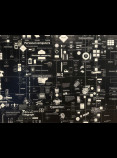Preamble

Calculating Empires fragment. Kate Crawford and Vladan Joler.
The exhibition begins with a journey through three installations and an audiovisual piece that provide context for the exhibition’s theme and directly engage visitors in an immersive way:
Calculating Empires: A Genealogy of Technology and Power, 1500–2025
Calculating Empires, an award-winning piece presented in the exhibition courtesy of the Prada Foundation, is a work by Kate Crawford and Vladan Joler. It explores how technical and social structures have evolved over five centuries. The goal is to view the contemporary period within a longer trajectory of ideas, devices, infrastructures, and systems of power. The piece traces the technological patterns of colonialism, militarization, and automation since the year 1500 to reveal how these forces continue to dominate today. By following these imperial paths, Calculating Empires offers a way to see present-day technology within a deeper historical context. Investigating how past empires have calculated allows us to understand how they created the conditions for today’s empire.
Situated Matter
The aim of this newly produced installation is to encourage visitors to question materiality through everyday objects used by a young person in Barcelona over the course of a day. Next to each object, information is provided on the type of material, its place of origin, its ecological impact at the source, its circularity potential, and possible alternatives to that material, if available.
Natura Morta
Nearly two hundred historical and contemporary pieces from the Museu del Disseny’s Ceramic Collection—primarily plates—are arranged iconographically: air (birds, clouds, sun, and stars), earth (trees, flowers, crops, forests, livestock, etc.), waterr (rivers, fish, ducks, etc.).
This space reflects on the relationship between humans and nature, the representation of nature in objects, and, specifically, in ceramic objects. The idea of nature is a social construct that modernity has upheld through binary oppositions such as natural vs. artificial, nature vs. culture, and nature vs. subject. In other words, it suggests living with the awareness that humans are not separate from nature—they are nature. Therefore, the relationship with design is fundamentally ecological.
Slow Violence
In Joanie Lemercier’s audiovisual piece, the brutal extractivism of the largest human-made machine in Europe is displayed, operating in the continent’s largest mine, located just a few kilometers from Cologne. The vision of a ravaged Earth provides context for the urgent need to rethink modes of creation, production, and consumption in order to transition to a decarbonized world that sustains life.


